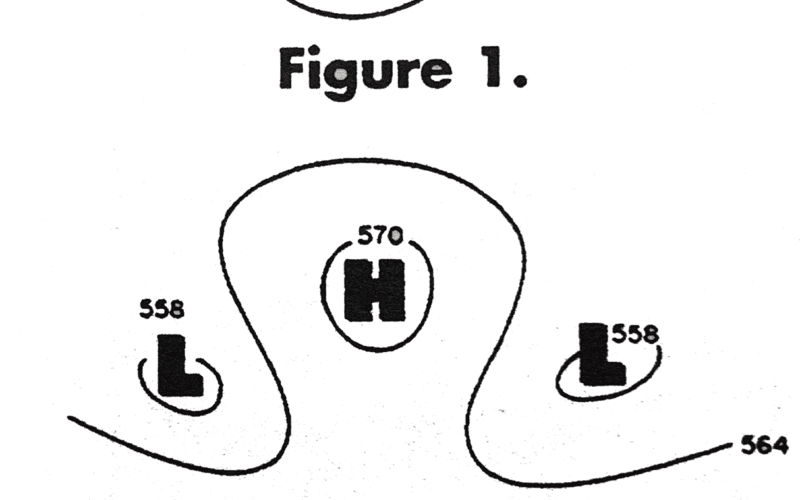 Omega blocks
Omega blocks
Upper atmosphere winds, blowing across the earth from west to east at speeds from 50 to 150 knots, help create and influence surface weather. Viewed from above Earth, these winds move along paths resembling ocean waves in profile.
Named for their length of hundreds of miles and for the scientist who first studied them, planetary waves or Rossby waves are found at an altitude of roughly 18,000 feet. Rossby waves move slowly, averaging 80 to 100 miles per day, but often become stationary and can even move backward. From Wikipedia on Rossby waves: “Atmospheric Rossby waves result from the conservation of potential vorticity and are influenced by the Coriolis force and pressure gradient. The rotation causes fluids to turn to the right as they move in the northern hemisphere and to the left in the southern hemisphere. For example, a fluid that moves from the equator toward the north pole will deviate toward the east; a fluid moving toward the equator from the north will deviate toward the west. These deviations are caused by the Coriolis force and conservation of potential vorticity which leads to changes of relative vorticity. This is analogous to conservation of angular momentum in mechanics. In planetary atmospheres, including Earth, Rossby waves are due to the variation in the Coriolis effect with latitude. Carl-Gustaf Arvid Rossby first identified such waves in the HYPERLINK “https://en.wikipedia.org/wiki/Earth%27s_atmosphere” \o “Earth’s atmosphere” Earth’s atmosphere in 1939 and went on to explain their motion.
“Most investigations of Rossby waves have been done on those in Earth’s atmosphere. Rossby waves in the earth’s atmosphere are easy to observe as (usually 4 to 6) large-scale meanders of the jet stream. When these deviations become very pronounced, masses of cold or warm air detach, and become low-strength HYPERLINK “https://en.wikipedia.org/wiki/Cyclone” \o “Cyclone” cyclones and HYPERLINK “https://en.wikipedia.org/wiki/Anticyclone” \o “Anticyclone” anticyclones, respectively, and are responsible for day-to-day weather patterns at mid-latitudes. The action of Rossby waves partially explains why eastern continental edges in the Northern Hemisphere, such as the Northeast United States and Eastern Canada, are colder than Western Europe at the same latitudes.”
The length and amplitude of these waves are influenced by the movement of warm and cold air masses to and from the equator and poles. On average, there are four to seven Rossby waves encircling the globe at any given time. Rossby waves frequently grow in amplification and shorten in wavelength, just as an ocean wave crests when it enters shallow water. As the waves do this, they begin to resemble the Greek letter omega (Ω).
A fully developed omega wave will often have a north-south dimension of 1,200 miles, with an east-west dimension of 800 miles. Due to both the physical size and general clockwise rotation of winds around an omega shape, they frequently block west-to-east movement of weather — thus their designation as blocking omega highs, or omega blocks.
Because of their clockwise rotation, omega blocks encourage and enhance surface-level highs, bringing barometric pressure to 1,030 millibars or greater.
An omega block is either a help or hindrance depending on a boat’s position relative to its strong features. Low-pressure systems approaching an omega block from the west are either stopped or pushed northward, over the top of the block (see diagram).
Additionally, winds on the west side of an omega block, blowing from the south, bring warm air northward, while on the east side the north-to-south flow of wind brings cold air south. This meridional airflow often causes stormy conditions that can last for days or weeks on either or both sides of an omega block.

